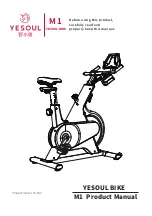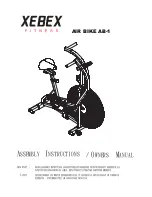
Customer Service 1-888-707-1880
Dyaco Canada Inc. 2015
Email:
40
Guidance and manufacturer’s declaration – electromagnetic compatibility
The MR100 is intended for use in the electromagnetic environment specified below. The customer or the user of the MR100 should assure
that it is used in such an environment.
Emissions test
Compliance
Electromagnetic environment
–
guidance
RF emissions
CISPR 11
Group 1
The MR100 uses RF energy only for its internal
function. Therefore, its RF emissions are very low and
are not likely to cause any interference in nearby
electronic equipment.
RF emissions
CISPR 11
Class B
The MR100 is suitable for use in all establishments,
including domestic establishments
Immunity test
IEC 60601
test level
Compliance level
Electromagnetic environment
–
guidance
Electrostatic
discharge (ESD)
IEC 61000-4-2
6 kV contact
8 kV air
6 kV contact
8 kV air
Floors should be wood, concrete or ceramic tile. If
floors are covered with synthetic material, the relative
humidity should be at least 30 %.
Power frequency
(50/60 Hz)
magnetic field
IEC 61000-4-8
3 A/m
3 A/m
Power frequency magnetic fields should be at levels
characteristic of a typical location in a typical
commercial or hospital environment.
Radiated RF
IEC 61000-4-3
3 V/m
80 MHz to 2,5 GHz
3 V/m
d = 1,2
80 MHz to 800 MHz
d = 2,3
800 MHz to 2,5 GHz
Where P is the maximum output power rating of the
transmitter in watts (W) according to the transmitter
manufacturer and d is the recommended separation
distance in meters (m).
Field strengths from fixed RF transmitters, as
determined by an electromagnetic site survey, a)
should be less than the compliance level in each
frequency range. B) Interference may occur in the
vicinity of equipment marked with the following
symbol:
Recommended separation distances between
portable and mobile RF communications equipment and the MR100
The MR100 is intended for use in an electromagnetic environment in which radiated RF disturbances are controlled. The customer or the user
of the MR100 can help prevent electromagnetic interference by maintaining a minimum distance between portable and mobile RF
communications equipment (transmitters) and the MR100 as recommended below, according to the maximum output power of the
communications equipment.
Separation distance according to frequency of transmitter
m
Rated maximum output
power of transmitter
W
150 kHz to 80 MHz
d =
1,2
80 MHz to 800 MHz
d =
1,2
800 MHz to 2,5 GHz
d =
2,3
0,01
0,12
0,12
0,23
0,1
0,38
0,38
0,73
1
1,2
1,2
2,3
10
3,8
3,8
7,3
100
12
12
23
For transmitters rated at a maximum output power not listed above, the recommended separation distance
d
in meters (m) can be estimated
using the equation applicable to the frequency of the transmitter, where
P
is the maximum output power rating of the transmitter in watts (W)
according to the transmitter manufacturer.
NOTE 1 At 80 MHz and 800 MHz, the separation distance for the higher frequency range applies.
NOTE 2 These guidelines may not apply in all situations. Electromagnetic propagation is affected by absorption and reflection from structures,
objects and people.


































